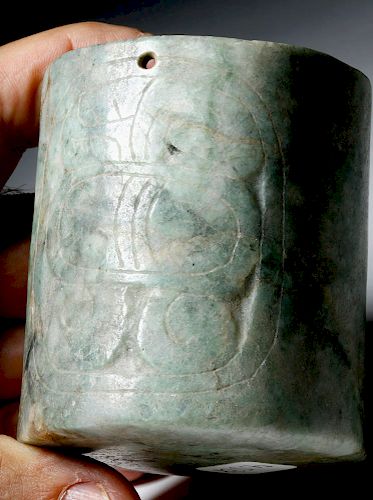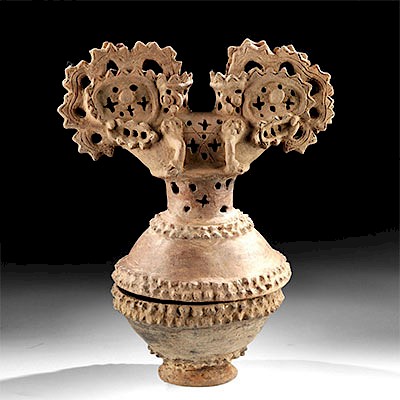Olmec Jadeite Cup - Engraved with Glyphs
Lot 74c
About Seller
Artemis Gallery
686 S Taylor Ave, Ste 106
Louisville, CO 80027
United States
Selling antiquities, ancient and ethnographic art online since 1993, Artemis Gallery specializes in Classical Antiquities (Egyptian, Greek, Roman, Near Eastern), Asian, Pre-Columbian, African / Tribal / Oceanographic art. Our extensive inventory includes pottery, stone, metal, wood, glass and textil...Read more
Categories
Estimate:
$7,000 - $10,500
Absentee vs Live bid
Two ways to bid:
- Leave a max absentee bid and the platform will bid on your behalf up to your maximum bid during the live auction.
- Bid live during the auction and your bids will be submitted real-time to the auctioneer.
Bid Increments
| Price | Bid Increment |
|---|---|
| $0 | $25 |
| $300 | $50 |
| $1,000 | $100 |
| $2,000 | $250 |
| $5,000 | $500 |
| $10,000 | $1,000 |
| $20,000 | $2,500 |
| $50,000 | $5,000 |
| $100,000 | $10,000 |
| $200,000 | $20,000 |
About Auction
By Artemis Gallery
Aug 22, 2019
Set Reminder
2019-08-22 10:00:00
2019-08-22 10:00:00
America/New_York
Bidsquare
Bidsquare : Fine Ancient | Asian | Ethnographic Art
https://www.bidsquare.com/auctions/artemis-gallery/fine-ancient-asian-ethnographic-art-4348
Featuring classical antiquities, ancient and ethnographic art from cultures encompassing the globe, plus fine art. Egyptian, Greek, Roman, Etruscan, Near Eastern, Asian, Pre-Columbian, Native American, African / Tribal, Oceanic, Spanish Colonial, Russian, Fine Art, so much more! Artemis Gallery info@artemisgallery.com
Featuring classical antiquities, ancient and ethnographic art from cultures encompassing the globe, plus fine art. Egyptian, Greek, Roman, Etruscan, Near Eastern, Asian, Pre-Columbian, Native American, African / Tribal, Oceanic, Spanish Colonial, Russian, Fine Art, so much more! Artemis Gallery info@artemisgallery.com
- Lot Description
Pre-Columbian, Mesoamerica, Olmec, ca. 700 to 500 BCE. Jade is a swirling milky white and turquoise color, translucent enough over approximately a third of its surface that light clearly shines through it. The exterior has two small holes drilled opposite each other at the rim; the exterior of the body is decorated with finely-incised glyph-like designs. The Olmecs, the first major culture known from Mesoamerica, created amazing jade carvings, many of them incised like this one. Jade seems to have been associated with water, vegetation, and young corn, the staple food of Olmec life. Based on burial practices, particularly the objects from important burials at La Venta in the present day Mexican state of Tabasco, we believe that jade was reserved for high nobility, royalty, and the gods. Size: 2.7" W x 2.9" H (6.9 cm x 7.4 cm)
The incised glyphs on this carving are probably epi-Olmec or proto-Mayan. Epi-Olmec, like Mayan, consists of glyphs, often written in lines or columns. Although not all of it has been deciphered, what we know of this language is that it describes religious notions and, to a lesser extent, socio-political matters. It is not clear if glyphs are both pictographic and ideographic, or what role phonograms might have played, and this remains a hotly studied component of Mesoamerican archaeology. With all these questions, can we say anything about this cup? Barring some exceptional circumstances, it was owned by a wealthy person, and buried with them; its glyphs probably speak to the status of the individual or offer a prayer.
Provenance: Ex - private LA County collection acquired before 1990
All items legal to buy/sell under U.S. Statute covering cultural patrimony Code 2600, CHAPTER 14, and are guaranteed to be as described or your money back.
A Certificate of Authenticity will accompany all winning bids.
We ship worldwide and handle all shipping in-house for your convenience.
#116298Excellent condition, with slight wear to surface but design clear.Condition
- Shipping Info
-
All shipping is handled in-house for your convenience. Your invoice from Artemis Gallery will include shipping calculation instructions. If in doubt, please inquire BEFORE bidding for estimated shipping costs for individual items.
-
- Buyer's Premium



 EUR
EUR CAD
CAD AUD
AUD GBP
GBP MXN
MXN HKD
HKD CNY
CNY MYR
MYR SEK
SEK SGD
SGD CHF
CHF THB
THB


















